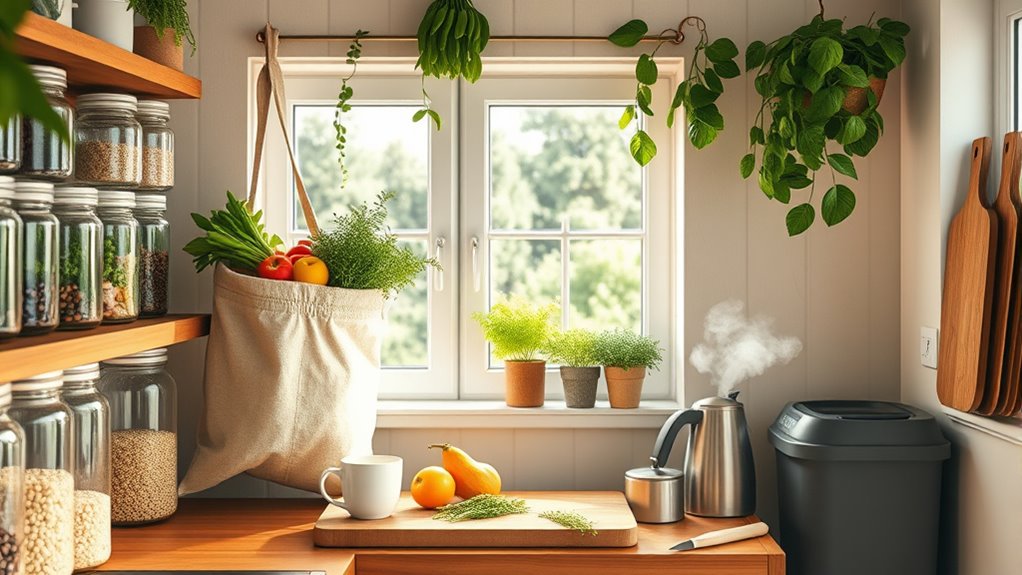Zero-waste living is all about minimizing waste and embracing sustainability. Start by evaluating your consumption habits and planning meals to reduce food waste. Adopt the “one in, one out” rule for possessions, and get creative by repurposing items like old glass jars or vintage sheets. Set up a compost bin for organic waste and familiarize yourself with local recycling guidelines. With these tips, you’ll take significant steps toward a zero-waste lifestyle and discover even more practical strategies.
Key Takeaways
- Evaluate your consumption habits to prioritize essentials and minimize unnecessary purchases.
- Plan meals ahead to reduce food waste and creatively utilize leftovers.
- Implement a “one in, one out” rule to effectively manage possessions.
- Choose reusable bags and buy in bulk to reduce packaging waste.
- Set up a compost bin for organic waste and participate in local recycling programs.
Understanding Zero-Waste Living
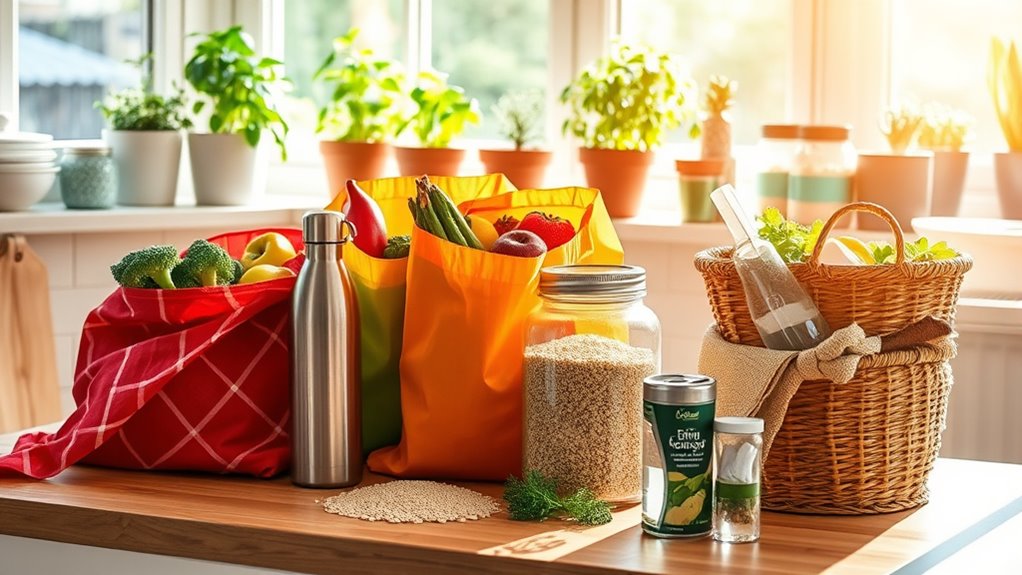
While many people may not realize it, zero-waste living is more than just a trendy catchphrase; it’s a lifestyle dedicated to eliminating waste and promoting sustainability. This approach focuses on redesigning resource life cycles, ensuring all products are reused or repurposed. The primary goal is to stop waste from entering landfills or polluting the environment. By adopting this lifestyle, you can reduce pollution, conserve resources, and support economic, environmental, and social well-being. However, it does require significant changes in your consumption habits. Embracing principles like resource efficiency and circular economy can lead to meaningful impact. With only about 9% of global plastic being recycled, understanding zero-waste living is essential for a healthier planet. Additionally, zero waste strategies focus on reducing, reusing, and recycling materials, underscoring the importance of waste prevention. By creating strong emotional bonds, individuals can foster a deeper commitment to sustainable practices within their communities. To enhance your efforts, consider employing effective workflow strategies that can optimize your resource management and minimize waste.
Strategies for Reducing Waste
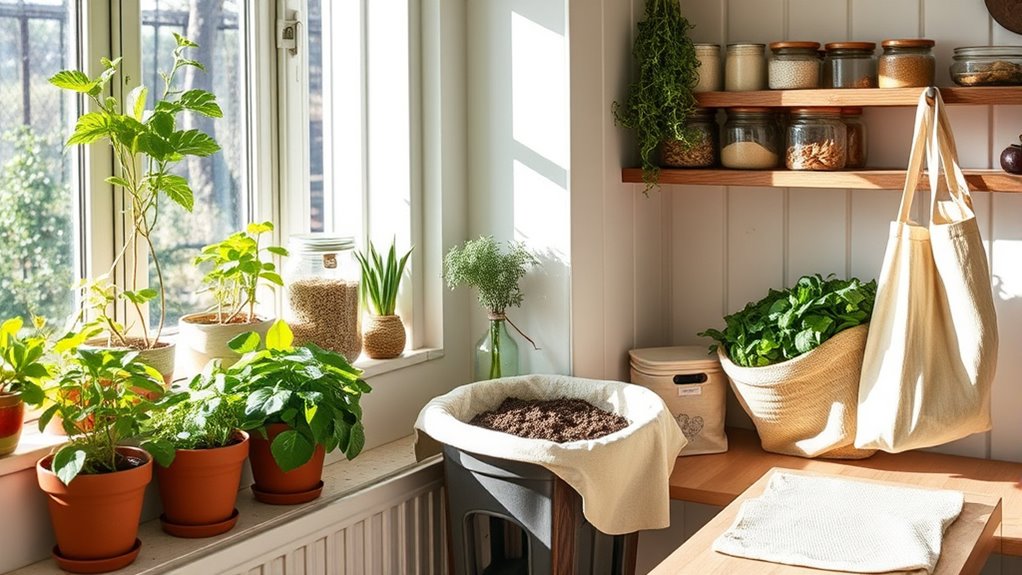
Adopting zero-waste living means actively seeking out strategies to reduce waste in everyday life. Start by evaluating your consumption patterns to spot unnecessary purchases and prioritize essentials. Consider the environmental impact of each item before buying, and use digital tools to track your consumption. Setting measurable waste reduction goals and involving others in your planning process is crucial for success. To minimize food waste, plan meals in advance, creatively use leftovers, and shop wisely to avoid excess. Additionally, consider that waste minimisation focuses on reducing waste at its source, which can significantly enhance your overall efforts. Implementing the “one in, one out” rule can also help manage your possessions and promote mindful living. Adopting a plant-based diet can further reduce your carbon footprint and contribute to zero waste efforts, as a vegetarian diet is linked to lower body mass index (BMI) and healthier weight. Reduce packaging use by buying in bulk and using reusable containers. Finally, engage with your community through cleanups or recycling programs.
Creative Reusing and Repurposing Ideas
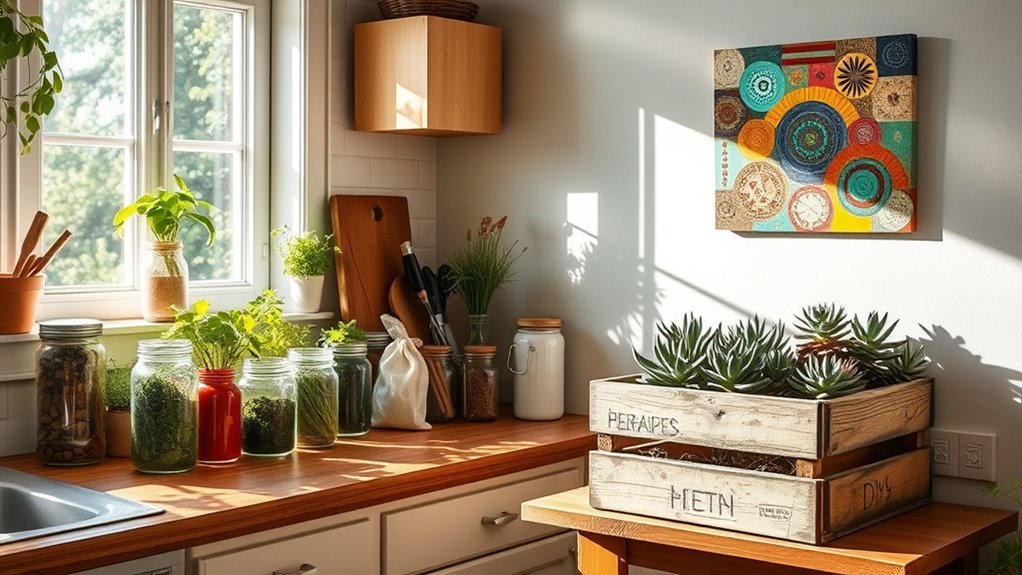
Finding creative ways to reuse and repurpose items can’t only reduce waste but also add a personal touch to your home. Consider old wood crates—turn them into stylish patio tables or unique bookcases. Those old jeans? They can become fun dog toys. Almost any item can be upcycled or repurposed, offering endless possibilities. Additionally, integrating color accuracy into your design choices can enhance the aesthetic appeal of your repurposed items. It’s important to remember that regular prenatal check-ups are advisable for monitoring your health while you’re busy with creative projects.
Moreover, using global flavors in your cooking can inspire you to repurpose food containers creatively, turning them into decorative pieces or functional kitchen storage. Don’t forget about glass jars; use them to organize your space or as decorative storage. Transform vintage sheets into beautiful tablecloths or shower curtains. For a quirky touch, upcycle old globes into unique light fixtures. Old ladders can serve as charming bookshelves, while cereal bags make excellent craft materials.
Effective Recycling and Composting Practices

As you embrace a zero-waste lifestyle, understanding effective recycling and composting practices is essential for minimizing your environmental impact. Start by familiarizing yourself with your local recycling guidelines to avoid contamination—remember, wish-cycling can cost more than landfilling. Focus on recycling materials like paper, aluminum, and metal, which make up the bulk of recyclables in the U.S. Notably, 59% of U.S. households have access to curbside recycling, making it easier than ever to participate in recycling efforts. Additionally, many communities offer educational resources that can help you understand the best practices for recycling and composting.
Set up a home compost bin to manage organic waste and create nutrient-rich soil for gardening. Participating in community composting programs can also boost waste diversion efforts. Finally, stay informed and educate others about proper recycling practices to improve overall efficiency and participation in your area. Every effort counts toward a more sustainable future!
Sustainable Shopping Habits
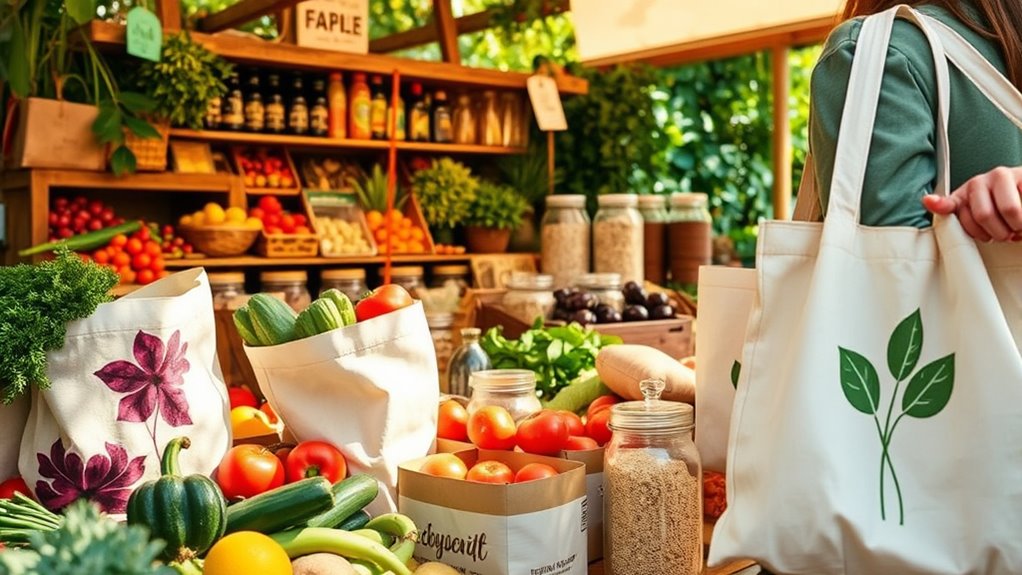
Sustainable Shopping Habits
When you commit to sustainable shopping habits, you not only reduce waste but also support a healthier planet. Start by using reusable bags made from organic cotton or recycled materials to cut down on plastic waste. Buy in bulk whenever possible, using your own containers to minimize packaging. Opt for products with minimal or biodegradable packaging and shop locally to decrease carbon emissions. Shopping the perimeter of the store helps you focus on fresh produce and other essentials without the excess plastic found in center aisles. Additionally, creating a clutter-free space can enhance your shopping experience and reduce impulse purchases. Choosing high-quality items can lead to a longer product lifespan, ultimately decreasing waste over time.
Evaluate your needs to avoid unnecessary purchases, and choose quality over quantity to extend product lifespans. A diversified investment in sustainable products can help create a positive environmental impact while saving money in the long run. Consider second-hand shopping to keep functional items out of landfills.
Finally, support local brands and select eco-friendly products packaged in glass or aluminum to further reduce waste. Embrace these habits for a more sustainable future!
Implementing Zero-Waste in Daily Life
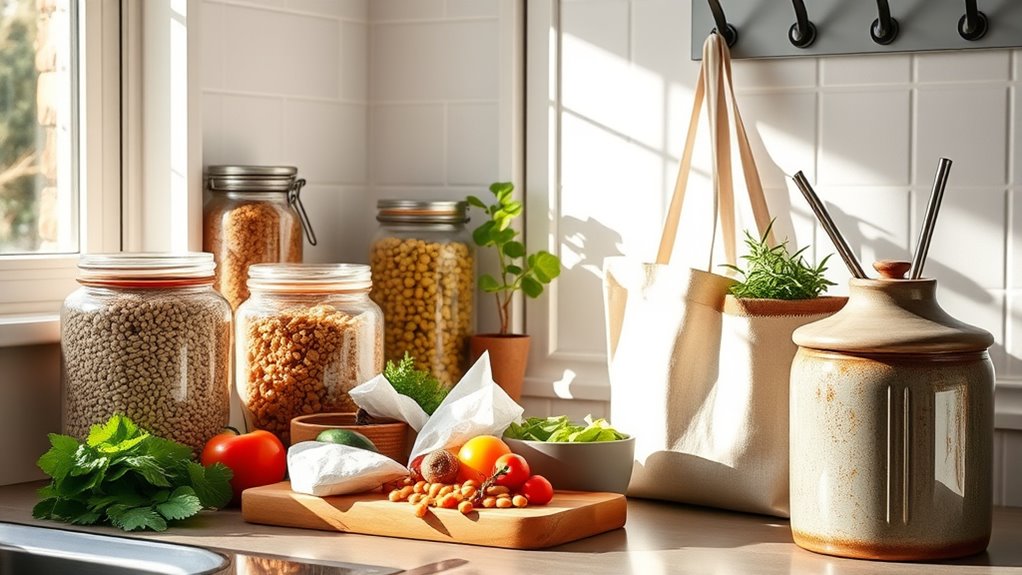
Implementing zero-waste practices in your daily life not only benefits the environment but also simplifies your routine.
Start your mornings with eco-friendly habits, like using a reusable water bottle or coffee cup. Meal planning helps you avoid food waste by ensuring you use ingredients before they expire. Additionally, consider buying coffee beans in bulk to reduce packaging waste and enhance your coffee experience. This practice aligns with the principles of waste management solutions, which focus on reducing unnecessary waste generation. Regularly checking and cleaning air purifier filters can also contribute to a healthier home environment by maintaining air quality. Incorporating freshly squeezed juices into your morning routine can also reduce waste from packaging.
Switch to bulk, eco-friendly cleaning products to cut down on packaging waste. Assess your daily consumption patterns to identify areas for improvement.
In personal care, buy toiletries in bulk, and opt for reusable hygiene products like metal razors and menstrual cups.
Finally, embrace a plant-based diet and compost food scraps to further minimize your impact.
With these simple adjustments, you’ll contribute to a sustainable lifestyle while making daily tasks more efficient.
Overcoming Challenges in Zero-Waste Living

Shifting to a zero-waste lifestyle can feel intimidating, especially with the various challenges that arise along the way. You might struggle with limited access to package-free products or face social pressures when dining out. Higher costs for sustainable items can strain your budget, while finding time for practices like composting adds to the challenge. However, you can overcome these obstacles! Start gradually, focusing on one area at a time. Consider DIY products to save money and utilize thrift stores for essentials. Engaging in local zero waste groups can provide support and shared resources. Additionally, exploring eco-friendly accommodations can help you find sustainable options when traveling. Carry reusable items to manage social situations and educate others about the benefits of zero-waste living. Incorporating routine health checks into your lifestyle can ensure that you consistently evaluate and improve your zero-waste efforts.
Frequently Asked Questions
What Are Some Common Misconceptions About Zero-Waste Living?
You might think zero-waste living means no waste at all, but it’s really about minimizing waste over time.
It’s not just recycling; reducing and reusing are crucial too. You may believe it’s inconvenient, but small changes can fit easily into your routine.
Plus, it’s not just for individuals—businesses and governments play important roles too.
How Can I Involve My Family in Zero-Waste Practices?
To involve your family in zero-waste practices, start by teaching them about recycling and composting.
Encourage repurposing old items into something useful, like turning clothes into rags.
Create fun family challenges to track waste reduction and reward progress.
Organize visits to recycling centers for hands-on learning and engage everyone in crafting with recyclables.
Are There Zero-Waste Brands I Should Support?
Absolutely, there are several zero-waste brands you should support!
Look into Blueland for cleaning products that use refillable systems, or check out Ecoroots for plastic-free packaging.
Cleancult offers eco-friendly cleaning solutions, while Dirty Labs features natural ingredients.
For beauty, try Davids Toothpaste or Plaine Products, which focuses on refillable options.
What Are the Financial Benefits of Zero-Waste Living?
You mightn’t realize it, but embracing a zero-waste lifestyle can save you money in unexpected ways.
By reducing disposal costs and lowering utility bills, you’ll notice your expenses shrink. Buying in bulk cuts packaging costs, and selling unwanted items can generate extra income.
Plus, investing in durable products means fewer replacements.
How Do I Handle Waste Management in Public Spaces?
To handle waste management in public spaces effectively, start by strategically placing clearly labeled recycling bins in high-traffic areas.
Make sure these bins are accessible and regularly maintained to encourage use.
Educate the community about proper recycling practices through engaging programs and clear signage.
Collaborate with local stakeholders to address challenges, and consider using smart technology to enhance efficiency.
Keeping the area clean and litter-free will also boost participation and support for your initiatives.
Conclusion
Embracing zero-waste living isn’t just a trend; it’s a glorious revolution! Imagine a world where your trash can is as empty as a magician’s hat after a grand performance. By adopting these tips and tricks, you’re not just reducing waste; you’re becoming a superhero for the planet! Every small step you take echoes through the ages, inspiring others to join the movement. So grab your reusable bags and strut into a cleaner, greener future—because you’ve got the power to change the world!
